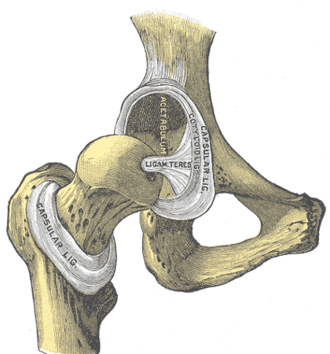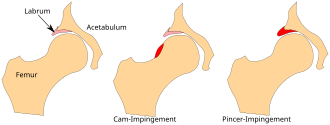Labral reconstruction
Surgical procedure to repair the labrum of a joint
Labral reconstruction is a surgical procedure aimed at repairing or reconstructing the labrum, a ring of cartilage that surrounds the socket of ball-and-socket joints such as the hip joint and shoulder joint. This procedure is often considered when the labrum is too damaged to be repaired through traditional methods or when previous repairs have failed.
Anatomy and Function[edit]

The labrum is a fibrocartilaginous structure that deepens the socket of the joint, providing stability and cushioning. In the hip joint, the labrum encircles the acetabulum, while in the shoulder joint, it surrounds the glenoid cavity. The labrum plays a crucial role in maintaining joint stability and facilitating smooth movement.
Indications for Labral Reconstruction[edit]
Labral reconstruction is typically indicated in cases where the labrum is irreparably damaged due to trauma, degenerative conditions, or previous surgical interventions. Common causes of labral damage include:
- Femoroacetabular impingement (FAI)
- Traumatic injuries, such as dislocations
- Degenerative conditions, such as osteoarthritis
- Failed previous labral repair surgeries
Surgical Techniques[edit]

Labral reconstruction involves the use of graft tissue to replace the damaged labrum. The procedure can be performed arthroscopically, which is minimally invasive, or through open surgery, depending on the extent of the damage and the surgeon's preference.
Graft Selection[edit]
The graft used for reconstruction can be autograft (harvested from the patient's own body) or allograft (donor tissue). Common sources for autografts include the iliotibial band or hamstring tendons.
Procedure[edit]
1. Arthroscopic Access: Small incisions are made to insert an arthroscope and surgical instruments into the joint. 2. Debridement: Damaged labral tissue is removed to prepare the site for graft placement. 3. Graft Preparation: The selected graft is prepared and shaped to match the anatomy of the native labrum. 4. Graft Fixation: The graft is secured to the bone using anchors or sutures, ensuring it is tensioned appropriately to mimic the function of the natural labrum.
Recovery and Rehabilitation[edit]
Postoperative recovery involves a period of rest followed by a structured rehabilitation program. The goals of rehabilitation are to restore range of motion, strengthen the surrounding musculature, and gradually return to normal activities. Full recovery can take several months, depending on the extent of the surgery and the patient's adherence to rehabilitation protocols.
Complications[edit]
Potential complications of labral reconstruction include:
- Infection
- Graft failure
- Persistent pain or stiffness
- Nerve injury
Related Pages[edit]

Ad. Transform your life with W8MD's Budget GLP-1 injections from $75


W8MD offers a medical weight loss program to lose weight in Philadelphia. Our physician-supervised medical weight loss provides:
- Weight loss injections in NYC (generic and brand names):
- Zepbound / Mounjaro, Wegovy / Ozempic, Saxenda
- Most insurances accepted or discounted self-pay rates. We will obtain insurance prior authorizations if needed.
- Generic GLP1 weight loss injections from $75 for the starting dose.
- Also offer prescription weight loss medications including Phentermine, Qsymia, Diethylpropion, Contrave etc.
NYC weight loss doctor appointmentsNYC weight loss doctor appointments
Start your NYC weight loss journey today at our NYC medical weight loss and Philadelphia medical weight loss clinics.
- Call 718-946-5500 to lose weight in NYC or for medical weight loss in Philadelphia 215-676-2334.
- Tags:NYC medical weight loss, Philadelphia lose weight Zepbound NYC, Budget GLP1 weight loss injections, Wegovy Philadelphia, Wegovy NYC, Philadelphia medical weight loss, Brookly weight loss and Wegovy NYC
|
WikiMD's Wellness Encyclopedia |
| Let Food Be Thy Medicine Medicine Thy Food - Hippocrates |
Medical Disclaimer: WikiMD is not a substitute for professional medical advice. The information on WikiMD is provided as an information resource only, may be incorrect, outdated or misleading, and is not to be used or relied on for any diagnostic or treatment purposes. Please consult your health care provider before making any healthcare decisions or for guidance about a specific medical condition. WikiMD expressly disclaims responsibility, and shall have no liability, for any damages, loss, injury, or liability whatsoever suffered as a result of your reliance on the information contained in this site. By visiting this site you agree to the foregoing terms and conditions, which may from time to time be changed or supplemented by WikiMD. If you do not agree to the foregoing terms and conditions, you should not enter or use this site. See full disclaimer.
Credits:Most images are courtesy of Wikimedia commons, and templates, categories Wikipedia, licensed under CC BY SA or similar.
Translate this page: - East Asian
中文,
日本,
한국어,
South Asian
हिन्दी,
தமிழ்,
తెలుగు,
Urdu,
ಕನ್ನಡ,
Southeast Asian
Indonesian,
Vietnamese,
Thai,
မြန်မာဘာသာ,
বাংলা
European
español,
Deutsch,
français,
Greek,
português do Brasil,
polski,
română,
русский,
Nederlands,
norsk,
svenska,
suomi,
Italian
Middle Eastern & African
عربى,
Turkish,
Persian,
Hebrew,
Afrikaans,
isiZulu,
Kiswahili,
Other
Bulgarian,
Hungarian,
Czech,
Swedish,
മലയാളം,
मराठी,
ਪੰਜਾਬੀ,
ગુજરાતી,
Portuguese,
Ukrainian